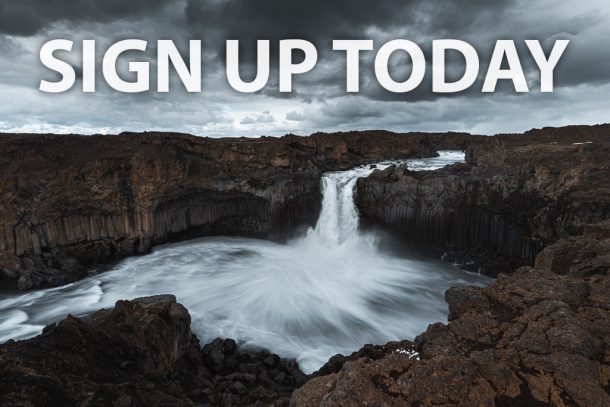We have put together a short manual for people who travelled all the way to Iceland for a glimps of the Northern Lights. These are 7 Crucial Settings for shooting the Northern Lights.
We are Iceland En Route a photo-travel agency that offers guidance for all level photographers, sets up tailor made private photo-tours and private tours for small groups with a professional photographer in Iceland. We also have a bundle of Photography Workshops all over the world for those who are looking for adventure and at the same time reach the next level in photography.
Many of our customers travel to Iceland during the winter to experience the winter in Iceland, most of them have a request for seeing, experiencing and photographing the Northern Lights. Of course if you are not used to photographing a moving object in the dark it can be quite tricky. But with good instructions anybody can get great photos of this majestic natural phenomenon.
We´ve set up this short and easy manual 7 Crucial Settings for the Northern Lights Photo shoot for the beginner/novelty photographer on how to set up the camera for the evening northern lights session. This manual works for whom ever has a camera with manual settings, regardless of brand or type.
Crucial Settings for shooting the Northern Light:
1. Tripod
You´ll need a tripod
The tripod needs to be sturdy enough to hold the camera and lens (we don´t want our expensive gear falling to the ground due to faulty or chea tripod)
In Iceland we normally have to have tripods and gear that can withold the windy conditions
You need a tripod in landscape photogrpahy and for night shots. If you don´t have one – buy one or at least rent one. All the settings that follow in this instructions don´t really work if the camera is shaking. The camera is working in the pitch dark, taking in the little light available and it needs a few seconds to do it´s work… even up to 30 sec and there´s no way any of us can stand completely still (whether it´s in the freezing temperatures or at all) and capture the magic shot that way. So unless you use a tripod the rest of this manual won´t work for you.
2. Manual settings
Both your camera and your lens have a manual setting and automatic setting.
Set both camera and lens to manual setting
Turn off the Image Stabilization
Why do we want to use manual settings? Because we want to be in control of the situation. The automatic settings will always try to focus in the dark and as your gear can´t focus in the dark it will try to turn on the flash and we don´t want that. The Flash Light will pollute your surroundings and annoy everyone around you. So with everything set to manual settings we are in control.
3. ISO Settings
Set your camera to ISO 3200
What is ISO and what does it do? ISO is the light sensitivity of the camera. The higher the ISO the less light your camera needs to take the photo (ad hence the lower the ISO the more light does it need to take a photo). But you need to know that the higher the ISO is the lower quality you get (photo becomes grainy).
4. Aperture (f-stop)
Use your lowest f-number, we suggest f2.8 if it´s available.
With changing the f-number you are changing the opening of your lens, through this opening the camera takes in light. To be able to take the photo while it´s pitch dark we want to open the lens as much as possible (to take in as much light as possible). Therefore we use the lowest f-stop available. This might seem confusing as it´s opposite to the ISO but just remember : ISO up = f-stop down. The lower the f-number is the more open the lens is and the more light it takes in and the faster it can work (shutterspeed). We want the camera to be able to work fast although it´s pitch dark because the Northern Lights are constantly moving in the sky. Always when you are photographing moving objects you want your camera to work fast.
5. Shutter speed
You could start at approx. 5 seconds
The shutter speed controls for how long your lens is open and absorbing the available light. The Northern Lights are moving and they have different strength so you are going to change the shutter speed as you are shooting. Strong light requires shutter speed 1-6 seconds while soft light requires 15-30 sec. So we are starting ar 5 sec but you are going to change this constantly until you find what suits you best.
6. Focus
Focus on a distant light (the moon, distant car light, whatever is avalable). Infinity mark on your lens is NOT necessarily right! During daylight you can focus on something distant to get your infinity, then mark it on your lens.
Although your camera might have auto focus it´s one of the settings that don´t work in the dark. So be sure to zoom out completely as you´ll want to get a wide photo of the Northern Lights.
7. Self timer, Remote control or an app
If you don´t own a remote control you´ll need to find a self timer on your camera
For a new camera there might also be an app available
As mentioned in the beginning we don´t want the camera to move while it´s doing it´s work so we are not goint to touch the camera prior to making the shot. Steady shot for an unblurred photo. Even the slightest wind can effect the outcome. We recommend some kind of a remote control to shoot with but not everybody has one so if that´s the case just find your self timer on the camera and set it for 10 seconds this means that although you need to touch the camera to shoot it will have settled from the motion in the 10 seconds it counts down before shooting.
With these 7 Crucial Settings for the Northern Lights Photoshoot you are all set to go and now it´s up to you to find an opening in the sky, a good foreground and wait for the magic to begin.
The tools for the trade
Those are of course the tools but practice makes perfect. Some of you might think I´m obsessed with this cliché … well you are right. Practice before using these setting out on the field. Play along with these settings in daylight, during the night and just when ever you have the time. You might find that the outcome is either too bright or too dark, adjust the ISO and shutter speed until you find the right setting. A bright photo requires lower ISO or shutter speed but too dark and you need to up the ISO or shutter speed. The more you play along with these settings and practice, the more likely you are to get the perfect photo. You might have a very short time to get the money shot, the Northern Lights usually don´t shine the whole night long. Sometimes they just make an appearance for a short time; boom! they appear, dance for a few minutes and disappear as quickly as they emerged. This won’t give you a lot of time to set the camera. Always pre-set the camera before you arrive on location and then adjust as needed!
For more tutorials and guidance on photographing the Northern Lights join us for a Workshop on the famous South Coast of Iceland or contact us for a tailor made private tour. Iceland En Route – bringing you an experience of a lifetime.
0




